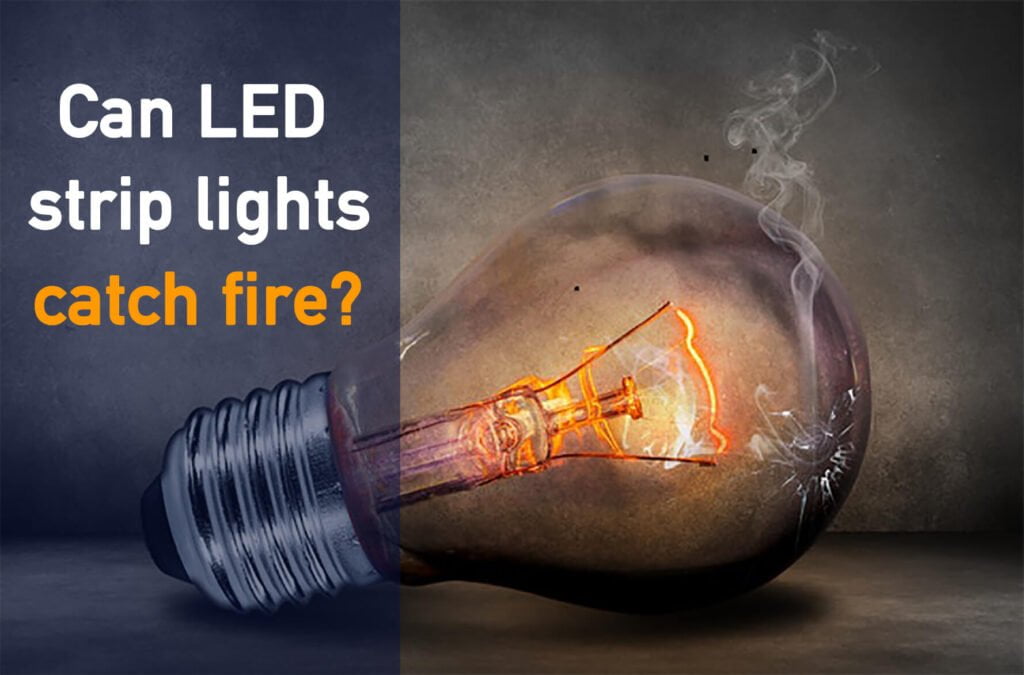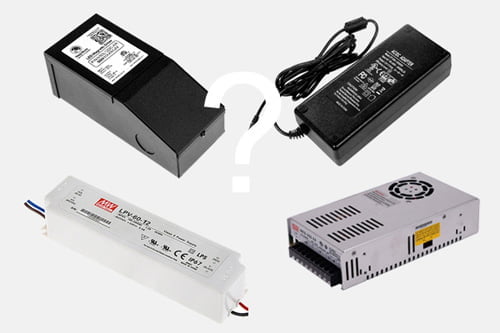Can LED Strip Lights Cause a Fire? Here’s What You Need to Know
Table of Contents
The prevalence of LEDs as a lighting solution is rising across commercial and residential landscapes. Still, concerns have been raised about the fire safety of LED strip lights. This piece delves into whether LED strip lights are fire hazards and the precautions necessary to mitigate potential risks.
LED strips aren’t likely to instigate a fire, as they don’t produce enough heat to ignite materials. The more significant danger stems from short or overloaded circuits, usually attributed to installation errors rather than inherent problems with the LED strips.

How can an incandescent bulb lead to a fire?
Incandescent bulbs function based on the thermal effect of electrical current. When an adequate current flows through the filament (typically made of tungsten), the filament heats up to around 3000°C and emits light. However, only about 10% of the energy consumed is converted into visible light, making incandescent bulbs less efficient.
An incandescent bulb’s surface temperature can reach about 180°C under typical conditions. Therefore, when in operation, if an incandescent bulb comes near flammable material, a fire can easily ensue.

Can LED strip lights overheat?
High-power, high-density LED strips can overheat if not mounted on aluminum profiles. Overheating accelerates the light decay of the LED strip, thereby shortening its lifespan.
Can LED strip lights harm you due to heat?
Touching an object with a temperature of 40 degrees Celsius would feel hot, while anything above 50 degrees Celsius could result in burns.
In most scenarios, LED strips won’t exceed 50 degrees Celsius. There are exceptions, like high-density, high-powered LED strip lights or circumstances with high ambient temperatures and inadequate heat dissipation. Under these conditions, the LED strip’s temperature could climb to 50 degrees. We seldom come in direct contact with LED strips, but wearing gloves during handling is recommended.
As a rule, it’s best to position LEDs out of reach for added safety for your children and pets.
Can LED strip lights catch fire?
Due to their low operating temperature, LED strips don’t typically fire hazards. The more significant risk lies in short or overloaded circuits, often due to incorrect installation, not problems inherent to the LED strips.
Short circuits pose the most significant risk of causing a fire. Opting for low-voltage LED strips and drivers with short-circuit protection is advisable.
High-voltage LED strips—those that directly connect to 110V or 220V mains—typically lack short-circuit protection. Nevertheless, MyLikeLed offers high-voltage LED strips with short-circuit and lightning protection.
Do LED strip lights become hot?
Often called cold light sources, LEDs convert electricity directly into light, making them considerably efficient—around 30%-50%. Compared to incandescent bulbs, the operational temperature of LEDs is low, generally within the 30-50 degrees Celsius range.
Can LED strip lights be left on all day safely?
Given their typical operating temperature of 30-50 degrees Celsius, LED strips are safe to keep on all day. Still, it’s advisable to turn them off when not necessary to save on electricity and extend their lifespan.
Are there other fire-related risks with LED strips?
While LED strips, particularly low-voltage ones, are generally safe, it’s essential to understand all potential fire triggers to ensure safe usage. Here are some factors to keep in mind:
1. Avoid low-quality LED strips
Cheap, low-quality LED strips often use defective raw materials, such as little copper in the FPCB, and are designed to operate at a higher current than the rated one for their LED lamp beads to compensate for the poor LED quality. This can result in considerable overheating.
2. Avoid utilizing a substandard, low-cost power supply
-
The power supply for LED lights is a critical component, and one should refrain from using inferior-quality LED power supplies.
-
These power supplies often deliver an inconsistent output voltage, sometimes surpassing the LED strip’s voltage, leading to overheating and even complete failure of the LED strip.
-
The real wattage of these inferior LED drivers tends to be less than indicated on their labels, commonly only 80% or even less of the labeled wattage.
-
Connecting the LED strip based on the labeled wattage can overload the current and induce overheating.
-
Typically, these substandard LED drivers lack short-circuit protection. This can lead to a dangerously high current in the LED strip if it’s incorrectly installed, causing overheating and potentially starting a fire.

3. Substandard Setup
Ensure that all joint connections are secured as tightly as they can be. Any slack in the connections may lead to increased resistance, excessive heat production, and the risk of sparking. Opt for soldering as a method over using solderless connectors.
4. Inappropriate wire size relative to strip light wattage
Before setting up the LED strip or doing any wiring, selecting a wire that matches the circuit’s rated current value is essential. As the power of the LED strip increases, a larger wire is required to prevent overheating and potential melting, which can lead to fires. The amount of current depends on multiple factors, including the number and length of light strips. Consequently, it’s important to calculate the maximum current on the circuit and determine the appropriate wire size before the installation process.

How to mitigate heat production in LED strips?
Heat can harm LED longevity, hence the need to minimize it where possible in LED strips.
1. Utilize LED aluminum casings
Using aluminum casings for LED strips is an effective method of mitigating heat. Aluminum is a practical solution as a good heat conductor and is reasonably priced.

2. Incorporate dimmers and motion detectors
LED strips don’t always have to operate at maximum brightness or continuously. Introducing dimmers can lower the intensity and energy consumption of the LED strip, thereby reducing heat production. Motion detectors can ensure that the LED strips are only on when necessary, contributing to a longer lifespan for your LED lights.
3. Opt for high-quality LED strips from reputable brands
While top-quality branded LED strips might be costlier, they often outlast their cheaper counterparts. High-quality LED strips can provide peace of mind, alleviating concerns about potential fire hazards.
4. Rely on professional installation
For optimal safety and performance, hiring a qualified electrician to install LED strips is crucial. Inadequate installation could lead to malfunctioning or, worse, a fire.
Final thoughts
While LED strip lights aren’t known for causing fires, there is always a little risk associated with electrical products. To minimize this risk, purchasing LED strip lights from reliable suppliers and adhering to the installation guidelines meticulously is wise.
MyLikeLed produces top-tier LED strips and LED neon flex. Our products undergo rigorous testing in state-of-the-art laboratories to ensure unmatched quality. Additionally, we provide various customization options for our LED strips and neon flex. Contact MyLikeLed today for your premium LED strip and LED neon flex needs!
FAQs
Yes, LED strip lights are safer than traditional incandescent bulbs. They produce less heat, reducing the risk of fire. However, always ensure you use high-quality, certified products and follow installation guidelines.
Common causes of LED strip light fires include using lights with poor-quality wiring, incorrect voltage, poor insulation, or faulty installation. Always ensure your LED strips are properly rated for your electrical setup.
Yes, LED strip lights are designed to run for extended periods, including overnight. However, make sure they are installed correctly and not in areas with poor ventilation to prevent overheating.
To prevent fires, use high-quality, certified LED strips, install them properly, and avoid overloading electrical circuits. Ensure the lights are in well-ventilated areas and turn them off when not in use.
If installed correctly and used with proper voltage, LED strip lights should not overheat. However, ensure the strips have adequate ventilation and do not block airflow around them to avoid excessive heat buildup.

Hi, I’m Xylia Xiong, a sales professional with 14 years of experience in the LED strip light industry. I specialize in providing tailored solutions, leveraging my expertise in LED products and the latest industry trends. Known for effective communication and problem-solving, I’m dedicated to helping lighting manufacturers, importers, and distributors achieve their goals.
Let’s work together to create customized solutions that exceed expectations.
Related Posts

The Best LED Strip Lights You Can Buy Right Now

Comparing WS2811 Vs WS2812B: Key Differences


